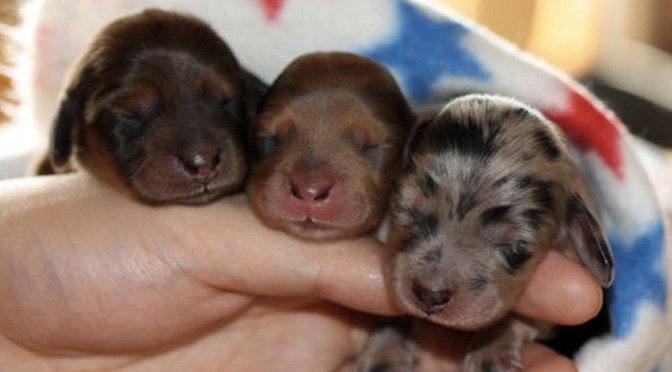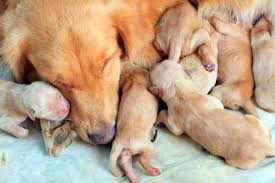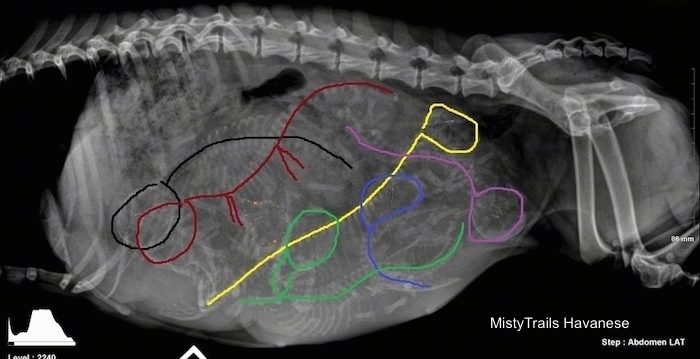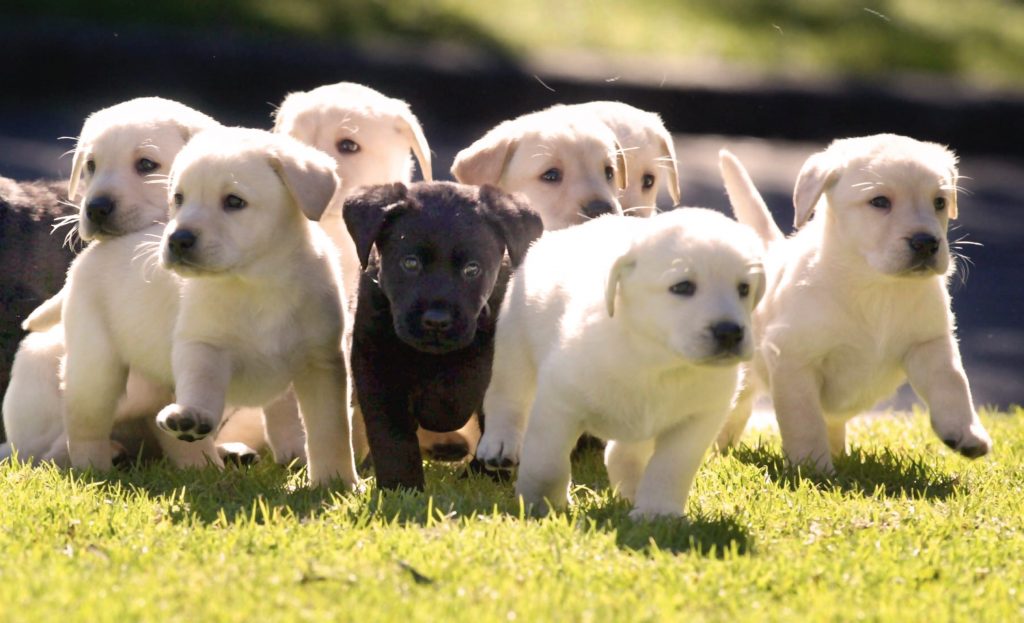 When a bitch is due to whelp it’s always an exciting time, whether you are an experienced breeder or a family expecting their first litter. It is a wonderful experience for children allowing them to witness nature at its best, first hand. The good news is that we usually don’t need to intervene as the natural motherly instinct is so strong that the mum somehow just knows what to do.
When a bitch is due to whelp it’s always an exciting time, whether you are an experienced breeder or a family expecting their first litter. It is a wonderful experience for children allowing them to witness nature at its best, first hand. The good news is that we usually don’t need to intervene as the natural motherly instinct is so strong that the mum somehow just knows what to do.
 Planning a litter is really important to ensure proper care and supervision is available at the time of whelping. This is done by monitoring the bitches heat cycle, not only to determine the best time for mating but is also allows us to accurately predict when she will give birth. In the last week of pregnancy it is recommended to have an X-ray taken to determine how many puppies to expect. Discuss this with us so that you can prepare for the litter and know what to expect. We try avoiding surprises in this aspect!
Planning a litter is really important to ensure proper care and supervision is available at the time of whelping. This is done by monitoring the bitches heat cycle, not only to determine the best time for mating but is also allows us to accurately predict when she will give birth. In the last week of pregnancy it is recommended to have an X-ray taken to determine how many puppies to expect. Discuss this with us so that you can prepare for the litter and know what to expect. We try avoiding surprises in this aspect!

So, the big day has arrived and mum will ideally have to be monitored during the birth process and a whelping box will need to be provided in a quiet secure place. If there are other dogs in the household, it’s a good idea to keep them separate so they don’t interfere with mum and stress her out unnecessarily. There are the odd occasions where the mum may kill or eat her puppies if they are harassed by other dogs. The usual signs of impending labour are nesting, panting, restlessness, may stop eating on the day, vomiting and licking at her vulva. This would be classified as stage 1 labour.
Stage 2 would be classified as an active process where you can typically see active pushing and contractions of the abdomen. It can take up to 30min for the first puppy to be born and can take up to 2 hours between puppies. In larger litters the bitch may even rest for a while.
 When to contact us at McDowall vets:
When to contact us at McDowall vets:
• A bloody or greenish discharge is seen BEFORE the birth of the first puppy, actually any discharge during pregnancy is not normal. A green discharge BETWEEN puppies is not significant as this indicates placental detachment during the birth process. A clear to slightly opaque slimy vaginal discharge may be seen up to 24h prior to giving birth. This is the loosening of the cervical plug and is completely normal.
• Active pushing for longer than 30-40 min with no puppies born
• Longer than 2 hours between puppies.
• Birth of a dead puppy, which may indicate a litter in peril.
• Retained placenta
Once the birth process has started the puppy is often delivered still enclosed in the foetal membranes. These will usually be gently pulled/ripped off by the bitch and the umbilical cord will also be chewed to separate the puppy from the placenta followed by vigorous licking of the puppy to stimulate breathing. If this is not done it needs to be done by the owner as to allow the puppy to start breathing. The umbilicus can then be tied off about 10mm from the abdominal wall using a thin string before the chord is cut and the puppy can then be dried and gently rubbed using a soft clean towel. This is where the value of having an X-ray done prior to whelping comes in as you will know exactly how many puppies to expect.
 Once all the puppies have been delivered the bitch will lie quietly and allow the pups to nurse. Also count the placentas as these can sometimes be retained causing potential health issues for the bitch. Bitches will normally eat the placentas as they come out, which is normal behaviour, but not essential and these can safely be removed and discarded. It is normal for the bitch to have a vaginal discharge post-partum; this can be dark greenish/black, brownish or slightly bloody. It usually has no smell and will slowly become less each day but can last 10-14 days. The bitch is clinically healthy when eating well and drinking well.
Once all the puppies have been delivered the bitch will lie quietly and allow the pups to nurse. Also count the placentas as these can sometimes be retained causing potential health issues for the bitch. Bitches will normally eat the placentas as they come out, which is normal behaviour, but not essential and these can safely be removed and discarded. It is normal for the bitch to have a vaginal discharge post-partum; this can be dark greenish/black, brownish or slightly bloody. It usually has no smell and will slowly become less each day but can last 10-14 days. The bitch is clinically healthy when eating well and drinking well.
 The first time the puppies suckle is extremely important as the first milk, called colostrum, contains all the necessary antibodies to help provide immunity for the puppies in the first 4-6 weeks of life. The puppy will only start producing its own antibodies from 4-6weeks of age. With larger litters it is important to check that all the puppies are drinking and that smaller pups are not being ‘bullied’ by bigger stronger pups. If smaller pups are pushed aside they will quickly become hypothermic and hypoglycaemic.
The first time the puppies suckle is extremely important as the first milk, called colostrum, contains all the necessary antibodies to help provide immunity for the puppies in the first 4-6 weeks of life. The puppy will only start producing its own antibodies from 4-6weeks of age. With larger litters it is important to check that all the puppies are drinking and that smaller pups are not being ‘bullied’ by bigger stronger pups. If smaller pups are pushed aside they will quickly become hypothermic and hypoglycaemic.
Puppies will need to be kept warm as they cannot thermo regulate (control their own body temperature) until they are about 10 days old. If the pups are all lying spread out far apart from each other or crawling out of the whelping box they are too hot, if they are all lying on top of each other they are too cold so happy pups are all huddled close to each other quietly sleeping. One can use a red light, heating pad or hot water bottles to supply some additional warmth, this is more important in the cooler months.
 The most important way to monitor a litter is to identify each puppy and weigh the puppies every day. Their weight will typically stay the same or even drop slightly in the first 24 hours but after that they should be gaining weight every day and double their birth weight by about 10 days. If the puppies are losing or not gaining weight you should contact us as soon as possible to discuss supplemental feeding and possible hand rearing techniques. The bitch should also be fed ad lib as her food intake will typically increase 4 fold during lactation. Her food bowl must never be empty! It’s sometimes a good idea to put a lactating bitch on to a good quality puppy kibble which is higher in protein and fat (Royal Canin mother and baby dog is a good choice). A liquid calcium supplement is recommended from birth to weaning for the mom to prevent eclampsia (milk fever), this is obtainable from most good pet stores. Eclampsia is more common in small breed dogs, less than 5kg with a large litter, usually seen at 7-14 days post-partum. Symptoms include uncontrollable shaking/shivering, panting, restlessness and even seizures if left untreated.
The most important way to monitor a litter is to identify each puppy and weigh the puppies every day. Their weight will typically stay the same or even drop slightly in the first 24 hours but after that they should be gaining weight every day and double their birth weight by about 10 days. If the puppies are losing or not gaining weight you should contact us as soon as possible to discuss supplemental feeding and possible hand rearing techniques. The bitch should also be fed ad lib as her food intake will typically increase 4 fold during lactation. Her food bowl must never be empty! It’s sometimes a good idea to put a lactating bitch on to a good quality puppy kibble which is higher in protein and fat (Royal Canin mother and baby dog is a good choice). A liquid calcium supplement is recommended from birth to weaning for the mom to prevent eclampsia (milk fever), this is obtainable from most good pet stores. Eclampsia is more common in small breed dogs, less than 5kg with a large litter, usually seen at 7-14 days post-partum. Symptoms include uncontrollable shaking/shivering, panting, restlessness and even seizures if left untreated.
 Also ensure that her food and water bowls are in close proximity to her whelping box as some bitches are reluctant to move away from the puppies. The puppies will be fed at regular intervals by the mom and she will stimulate urination and defecation by licking and cleaning the perineal area of all the pups. You will see lot of changes in the pups at 10-14 days of age as this is when their ears open, eyes open and they will start moving around more. Bitches will usually start the weaning process from around 4-5 weeks with pups being weaned at around 6 weeks of age. It’s acceptable to start introducing solids from as early as 3 weeks already. This is easily done by moistening some puppy kibble to make a sloppy porridge or buying a soft tinned puppy food. The puppies will quickly start lapping at the food…often a very messy process in the beginning.
Also ensure that her food and water bowls are in close proximity to her whelping box as some bitches are reluctant to move away from the puppies. The puppies will be fed at regular intervals by the mom and she will stimulate urination and defecation by licking and cleaning the perineal area of all the pups. You will see lot of changes in the pups at 10-14 days of age as this is when their ears open, eyes open and they will start moving around more. Bitches will usually start the weaning process from around 4-5 weeks with pups being weaned at around 6 weeks of age. It’s acceptable to start introducing solids from as early as 3 weeks already. This is easily done by moistening some puppy kibble to make a sloppy porridge or buying a soft tinned puppy food. The puppies will quickly start lapping at the food…often a very messy process in the beginning.
When to contact us at McDowall Vets:
• When a lactating bitch stops eating.
• Any continuous shivering/shaking and panting possibly indicating eclampsia
• Puppies losing or not gaining weight.
• Puppies continuously crying
• First deworming should be done at 2 weeks, then every 2 weeks thereafter.
• 1st vaccination must be done at 6 weeks of age
• Microchipping is usually done at about 8 weeks
One can easily see how important it is to plan properly for the litter to avoid unnecessary stress. So it’s good to discuss this and any other concerns with us who will be able to guide and assist you every step of the way. It’s hard work but so rewarding and exciting at the same time, and a wonderful experience to watch and enjoy.


